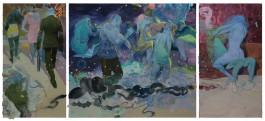
This selection of exhibitions to see serves as a bridge in this transitional season, helping us let go of this August and exciting us for what's to come in September, while reflecting on many important themes on our way there.
Neue Nationagalerie is presenting the first retrospective in Germany of the acclaimed Brazilian artist Lygia Clarke. Open until October 12, this comprehensive exhibition walks us through her entire practice. Throughout her career, Clarke’s main focus has been the relationship between artist and viewer, artwork and space. The discarding of boundaries between the two was an immediate thing for her, who in 1959 became a leading figure of the Neo-Concrete Movement. Her art developed to become an organic phenomenon, a sensorial experience, and towards the end, even a therapeutic practice.
Switching the role of viewers into active participants and directly addressing their senses are some of the artworks presented in the exhibition, like her Sensorial Objects or O Eu o Tu (Série Roupa-Corpo-Roupa). Bodies are gently forced to interact with each other, to focus on themselves and on what they feel. In the context of the dictatorship under which these artworks were created, they also assume another important role, a political one: trying to help liberate people from the constraints and limitations they were facing.
Creating another stunning connection between viewer and artwork is the site-specific sculpture by Fujiko Nakaya, hosted in Neue Nationalgalerie's sculpture garden. The artist is famous for her fog sculptures, creating a dreamy and immersive environment for the viewers. Her work is both monumental and ephemeral, recreating a natural phenomenon that envelops the audience and mesmerizes them. It is a dialogue between art and nature, artist and viewer, creating a powerful and unexpected space for us to experience. In the fog everything blurs and all things are connected again, making us feel at one with everything that surrounds us.
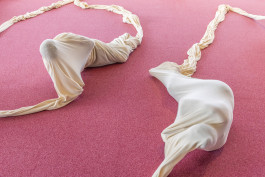
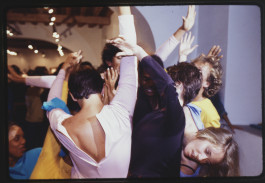
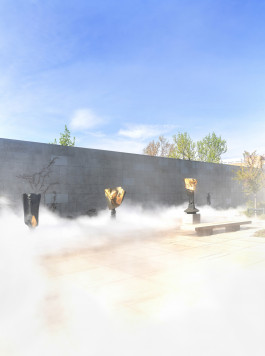
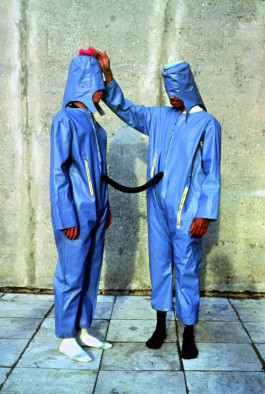
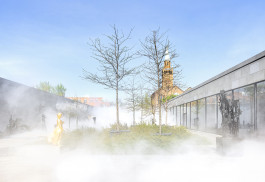
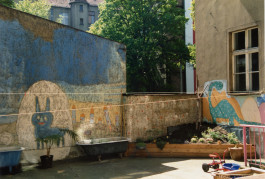
Focusing on one of the most charming and iconic spots in Berlin, its backyards, is the exhibition Berliner Höfe at Museum Ephraim-Palais. Berlin’s backyards are a fundamental architectural feature of the city: diverse, lively spaces with many different functions. The exhibition explores them, presenting their variety and their important role across time. Through them, we witness the evolution of Berlin, from its industrial revolution, across the wars, and now in contemporary times.
What strikes the most is not only their multifunctionality, but also their multiculturality. They speak of a city that has welcomed many people from different countries and backgrounds, and became their new home. It is a very important topic, especially in contemporary times, that addresses the importance of inclusion, diversity, possibilities, and change. These images function as bridges between the past and the future of the city, giving us new interesting insights on its roots and on how to deal with the issues of our present.
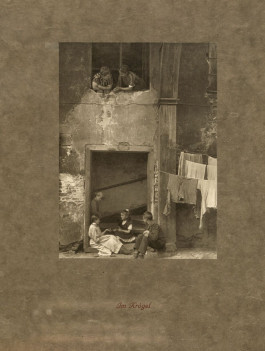
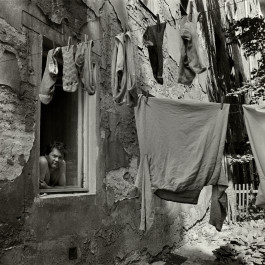
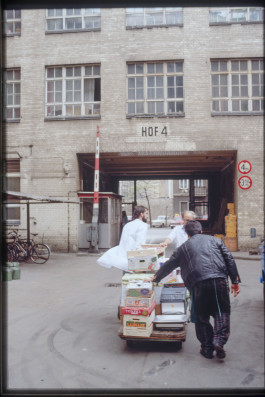
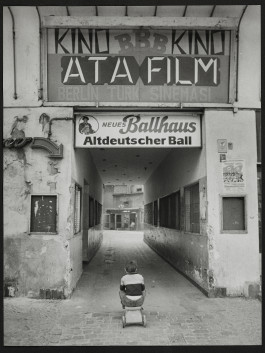
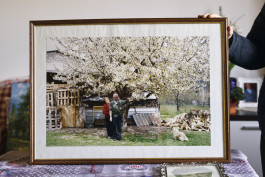
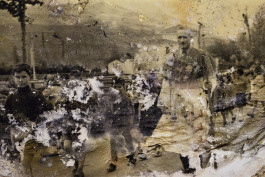
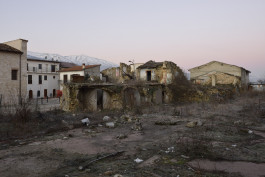
Talking about lived spaces, though in this case ones that were unfortunately lost for different reasons, is the exhibition Voices in Search of One Another by Göran Gnaudschun at Haus am Lützowplatz. His lens focuses on the Italian city of Onna, which was devastated by a powerful earthquake in 2009. Portraying what remains and the faces of the people impacted by the tragedy, Gnaudschun's work tells us about the pain of a city, but also of its resilience through many hardships.
The city suffered during World War II, when retreating German soldiers carried out a massacre and destroyed many of its buildings. Thus, the project becomes a process of atonement and recognition of past mistakes, which is also why the exhibition opened on the occasion of the 80th anniversary of Europe’s liberation from National Socialism.
Onna stands as a powerful symbol of the huge suffering of civilians during wars, of how profoundly some events shape people's lives, and of how trauma can pass on from one generation to another. Yet, it also carries a message of hope. As the artist writes: “I saw grief and pain in their faces, but also resilience and strength, a deep will to carry on, to look ahead – for the family, for others, and for those who were so suddenly torn from life. I delved deep into the village’s past through archive material and private photographs. The overflowing images of the past intertwine with the quiet, deserted scenes of the present.”
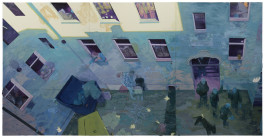
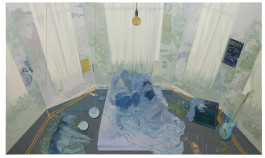
Their program will continue with another impactful exhibition opening for Berlin Art Week, which we are thrilled to fully cover in next month's review. Haus am Lützowplatz will present Herbst (Autumn) by Ruprecht von Kaufmann. Intertwining in this case Germany’s present with the past of the Weimar Republic, his paintings are unsettling, and the parallels between them are disturbing. We find ourselves once again in a time of political upheaval, filled with economic and political crises, with many conflicts surrounding us, and with a resurgence of right-wing populism. His paintings connect the dots of these unsettling times, making us reason on them in a new and challenging way.
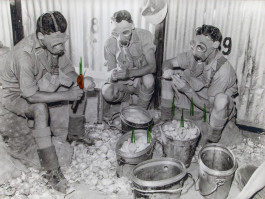
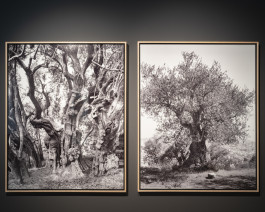
Also reflecting on the deep interconnection between places and people is the exhibition program ‘aʿmāl al-’arḍ – Landworks, Collective Action, and Sound at Spore Initiative. Following its participation as a collateral event in the 60th Venice Biennale, the project has taken on a new form, now co-organized by Spore Initiative and Dar Yusuf Nasri Jacir for Art and Research (Dar Jacir), an experimental interdisciplinary learning hub in Bethlehem.
The presented artworks explore land, agriculture, and heritage as spaces of resilience, memory, and collective practice. In a troubling present, where fundamental rights are constantly violated in the most brutal ways, both in Palestine and in the West Bank, the exhibition highlights the atrocious sufferings of their people, and explores creative strategies to confront them.
In the works by Adam Broomberg and Baha Hilo, olive trees become a powerful symbol of colonial violence, but most of all of the resilience of the population despite all the destruction they are forced to live in. We witness different and stratified forms of violence, balanced by powerful acts of resistance. Through all the artworks presented, aʿmāl al-’arḍ makes us reflect on the profound meaning of taking care of a land, which is not only about sustenance, but above all is about survival, practice, and a sense of belonging.
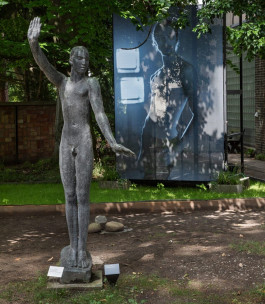
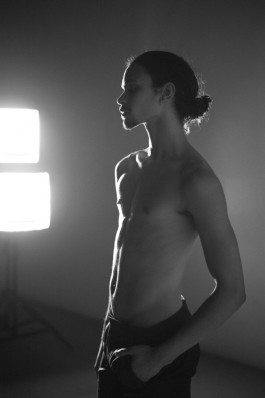
Addressing social injustice and reconnecting humanity with its surroundings is the exhibition held in the garden of Georg Kolbe Museum, running until September 28. There, David Hartt presents his installation, Metabolic Rift. The title comes from a Marxist theory, highlighting how the capitalistic system can disrupt the vital connections between people and nature, and underscores the sense of alienation that comes with it.
Through a powerful video installation, Hartt makes us reason on the stratification of racism, the power of defiance, and the possibility of changing and rebelling against preconceived notions surrounding humans and nature. The video is a direct response to Kolbe's Dancer's Fountain installed in the garden, and addresses not only racism, but also the uncontrolled exploitation of nature that has marked our path as humans, from colonization to capitalism. It has deprived many people of the fruits of their lands, and of a future. It has removed us from our ancestral contact with nature, using it only for economic purposes. Hartt's practice presents all of this in a charming and powerful way, encouraging us to think that a different future – a fairer one – can and has to be possible.
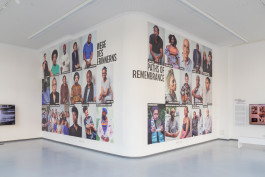
Another direct answer to the issue of systemic racism is the exhibition Paths of Remembrance at Galerie Wedding – Space for Contemporary Art. The exhibition celebrates the key figures who dedicated their life to the transformation of Berlin’s cultural spaces and the acknowledgment of Germany's colonial past. Whether they worked in the arts or in various other fields, all these figures were able to impact and change the sociopolitical life of the city for the better, and it is important to get to know their stories.
“Postcolonial remembrance means an earnest recognition of people in their multiplicity. It means recognizing stories so far untold, especially those of resistance, as an integral part of a national history embedded within a European and global context. Remembrance work will not change power structures overnight, but it can lay the foundation for a different, more just future; a future in which colonialism will no longer be possible.” – Dr. Ibou Coulibaly Diop & Julien Enzanza.
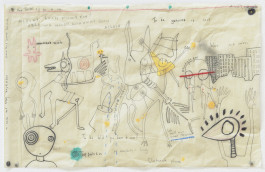
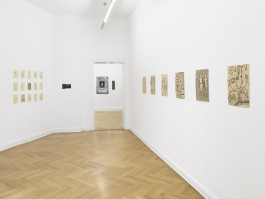
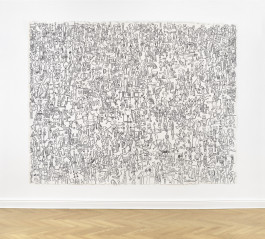
For those who plan to enjoy their last summer days in Berlin, there is another exhibition that is worth seeing. Until August 30, Galerie Friese will present Ambra Durante's On death and Dreaming. Durante's practice is based on drawing, and she literally draws on any material she can find. Her storytelling connects literature, music, and everyday life, creating a powerfully fragmented yet compact dialogue. These stories of death and dreaming are a powerful image of the chaos of our inner lives, projected on the outside and speaking to our chores. They address our humanity and our inner turmoil, connecting us all as people experiencing similar things. It is a portrait of a humanity that is struggling but also trying to be better, constantly shifting from one liminal space to another.
Yes, it will soon be time to let summer go once again. And it is certainly a hard thing to do, especially when the sun is finally out to brighten our days. It is okay to feel sad, but we all know that the sadness we might be feeling is not just weather-related. If one stops and thinks about all the unsettling things happening around us, it is impossible not to feel overwhelmed. Yet, all these exhibitions can provide us with inspiration, hope, and powerful means to understand our reality and our interconnection, and to make the world a better place for all. Don’t miss the chance to see these compelling exhibitions and see where this journey takes you.
Related Articles:

This selection of exhibitions to see serves as a bridge in this transitional season, helping us let go of this August and exciting us for what's to come in September, while reflecting on many important themes on our way there.
Neue Nationagalerie is presenting the first retrospective in Germany of the acclaimed Brazilian artist Lygia Clarke. Open until October 12, this comprehensive exhibition walks us through her entire practice. Throughout her career, Clarke’s main focus has been the relationship between artist and viewer, artwork and space. The discarding of boundaries between the two was an immediate thing for her, who in 1959 became a leading figure of the Neo-Concrete Movement. Her art developed to become an organic phenomenon, a sensorial experience, and towards the end, even a therapeutic practice.
Switching the role of viewers into active participants and directly addressing their senses are some of the artworks presented in the exhibition, like her Sensorial Objects or O Eu o Tu (Série Roupa-Corpo-Roupa). Bodies are gently forced to interact with each other, to focus on themselves and on what they feel. In the context of the dictatorship under which these artworks were created, they also assume another important role, a political one: trying to help liberate people from the constraints and limitations they were facing.
Creating another stunning connection between viewer and artwork is the site-specific sculpture by Fujiko Nakaya, hosted in Neue Nationalgalerie's sculpture garden. The artist is famous for her fog sculptures, creating a dreamy and immersive environment for the viewers. Her work is both monumental and ephemeral, recreating a natural phenomenon that envelops the audience and mesmerizes them. It is a dialogue between art and nature, artist and viewer, creating a powerful and unexpected space for us to experience. In the fog everything blurs and all things are connected again, making us feel at one with everything that surrounds us.






Focusing on one of the most charming and iconic spots in Berlin, its backyards, is the exhibition Berliner Höfe at Museum Ephraim-Palais. Berlin’s backyards are a fundamental architectural feature of the city: diverse, lively spaces with many different functions. The exhibition explores them, presenting their variety and their important role across time. Through them, we witness the evolution of Berlin, from its industrial revolution, across the wars, and now in contemporary times.
What strikes the most is not only their multifunctionality, but also their multiculturality. They speak of a city that has welcomed many people from different countries and backgrounds, and became their new home. It is a very important topic, especially in contemporary times, that addresses the importance of inclusion, diversity, possibilities, and change. These images function as bridges between the past and the future of the city, giving us new interesting insights on its roots and on how to deal with the issues of our present.







Talking about lived spaces, though in this case ones that were unfortunately lost for different reasons, is the exhibition Voices in Search of One Another by Göran Gnaudschun at Haus am Lützowplatz. His lens focuses on the Italian city of Onna, which was devastated by a powerful earthquake in 2009. Portraying what remains and the faces of the people impacted by the tragedy, Gnaudschun's work tells us about the pain of a city, but also of its resilience through many hardships.
The city suffered during World War II, when retreating German soldiers carried out a massacre and destroyed many of its buildings. Thus, the project becomes a process of atonement and recognition of past mistakes, which is also why the exhibition opened on the occasion of the 80th anniversary of Europe’s liberation from National Socialism.
Onna stands as a powerful symbol of the huge suffering of civilians during wars, of how profoundly some events shape people's lives, and of how trauma can pass on from one generation to another. Yet, it also carries a message of hope. As the artist writes: “I saw grief and pain in their faces, but also resilience and strength, a deep will to carry on, to look ahead – for the family, for others, and for those who were so suddenly torn from life. I delved deep into the village’s past through archive material and private photographs. The overflowing images of the past intertwine with the quiet, deserted scenes of the present.”


Their program will continue with another impactful exhibition opening for Berlin Art Week, which we are thrilled to fully cover in next month's review. Haus am Lützowplatz will present Herbst (Autumn) by Ruprecht von Kaufmann. Intertwining in this case Germany’s present with the past of the Weimar Republic, his paintings are unsettling, and the parallels between them are disturbing. We find ourselves once again in a time of political upheaval, filled with economic and political crises, with many conflicts surrounding us, and with a resurgence of right-wing populism. His paintings connect the dots of these unsettling times, making us reason on them in a new and challenging way.


Also reflecting on the deep interconnection between places and people is the exhibition program ‘aʿmāl al-’arḍ – Landworks, Collective Action, and Sound at Spore Initiative. Following its participation as a collateral event in the 60th Venice Biennale, the project has taken on a new form, now co-organized by Spore Initiative and Dar Yusuf Nasri Jacir for Art and Research (Dar Jacir), an experimental interdisciplinary learning hub in Bethlehem.
The presented artworks explore land, agriculture, and heritage as spaces of resilience, memory, and collective practice. In a troubling present, where fundamental rights are constantly violated in the most brutal ways, both in Palestine and in the West Bank, the exhibition highlights the atrocious sufferings of their people, and explores creative strategies to confront them.
In the works by Adam Broomberg and Baha Hilo, olive trees become a powerful symbol of colonial violence, but most of all of the resilience of the population despite all the destruction they are forced to live in. We witness different and stratified forms of violence, balanced by powerful acts of resistance. Through all the artworks presented, aʿmāl al-’arḍ makes us reflect on the profound meaning of taking care of a land, which is not only about sustenance, but above all is about survival, practice, and a sense of belonging.


Addressing social injustice and reconnecting humanity with its surroundings is the exhibition held in the garden of Georg Kolbe Museum, running until September 28. There, David Hartt presents his installation, Metabolic Rift. The title comes from a Marxist theory, highlighting how the capitalistic system can disrupt the vital connections between people and nature, and underscores the sense of alienation that comes with it.
Through a powerful video installation, Hartt makes us reason on the stratification of racism, the power of defiance, and the possibility of changing and rebelling against preconceived notions surrounding humans and nature. The video is a direct response to Kolbe's Dancer's Fountain installed in the garden, and addresses not only racism, but also the uncontrolled exploitation of nature that has marked our path as humans, from colonization to capitalism. It has deprived many people of the fruits of their lands, and of a future. It has removed us from our ancestral contact with nature, using it only for economic purposes. Hartt's practice presents all of this in a charming and powerful way, encouraging us to think that a different future – a fairer one – can and has to be possible.

Another direct answer to the issue of systemic racism is the exhibition Paths of Remembrance at Galerie Wedding – Space for Contemporary Art. The exhibition celebrates the key figures who dedicated their life to the transformation of Berlin’s cultural spaces and the acknowledgment of Germany's colonial past. Whether they worked in the arts or in various other fields, all these figures were able to impact and change the sociopolitical life of the city for the better, and it is important to get to know their stories.
“Postcolonial remembrance means an earnest recognition of people in their multiplicity. It means recognizing stories so far untold, especially those of resistance, as an integral part of a national history embedded within a European and global context. Remembrance work will not change power structures overnight, but it can lay the foundation for a different, more just future; a future in which colonialism will no longer be possible.” – Dr. Ibou Coulibaly Diop & Julien Enzanza.



For those who plan to enjoy their last summer days in Berlin, there is another exhibition that is worth seeing. Until August 30, Galerie Friese will present Ambra Durante's On death and Dreaming. Durante's practice is based on drawing, and she literally draws on any material she can find. Her storytelling connects literature, music, and everyday life, creating a powerfully fragmented yet compact dialogue. These stories of death and dreaming are a powerful image of the chaos of our inner lives, projected on the outside and speaking to our chores. They address our humanity and our inner turmoil, connecting us all as people experiencing similar things. It is a portrait of a humanity that is struggling but also trying to be better, constantly shifting from one liminal space to another.
Yes, it will soon be time to let summer go once again. And it is certainly a hard thing to do, especially when the sun is finally out to brighten our days. It is okay to feel sad, but we all know that the sadness we might be feeling is not just weather-related. If one stops and thinks about all the unsettling things happening around us, it is impossible not to feel overwhelmed. Yet, all these exhibitions can provide us with inspiration, hope, and powerful means to understand our reality and our interconnection, and to make the world a better place for all. Don’t miss the chance to see these compelling exhibitions and see where this journey takes you.
Related Articles:
You need to load content from reCAPTCHA to submit the form. Please note that doing so will share data with third-party providers.
More InformationYou need to load content from Turnstile to submit the form. Please note that doing so will share data with third-party providers.
More InformationYou are currently viewing a placeholder content from Facebook. To access the actual content, click the button below. Please note that doing so will share data with third-party providers.
More InformationYou are currently viewing a placeholder content from Instagram. To access the actual content, click the button below. Please note that doing so will share data with third-party providers.
More InformationYou need to load content from hCaptcha to submit the form. Please note that doing so will share data with third-party providers.
More InformationYou need to load content from reCAPTCHA to submit the form. Please note that doing so will share data with third-party providers.
More InformationYou are currently viewing a placeholder content from Turnstile. To access the actual content, click the button below. Please note that doing so will share data with third-party providers.
More InformationYou are currently viewing a placeholder content from X. To access the actual content, click the button below. Please note that doing so will share data with third-party providers.
More Information